Introduction of Leaflets in an Organization for Patient Better Understanding of His Disease-Diabetes
Critically explore the leadership and management within an organisation, considering the challenges faced in introducing a change and how to address them.
24 Pages6605 Words41 Views
Added on 2023-01-20
About This Document
This essay discusses the introduction of leaflets in an organization for better patient understanding of diseases like diabetes. It explores the role of clinical leadership in change management and the consequences of poor patient understanding of illness. The essay also highlights the importance of self-supervision and patient understanding in diabetes management.
Introduction of Leaflets in an Organization for Patient Better Understanding of His Disease-Diabetes
Critically explore the leadership and management within an organisation, considering the challenges faced in introducing a change and how to address them.
Added on 2023-01-20
ShareRelated Documents
Running head: HEALTHCARE-PUBLIC HEALTH
HEALTHCARE-PUBLIC HEALTH
Name of the Student:
Name of the University:
Author note:
HEALTHCARE-PUBLIC HEALTH
Name of the Student:
Name of the University:
Author note:
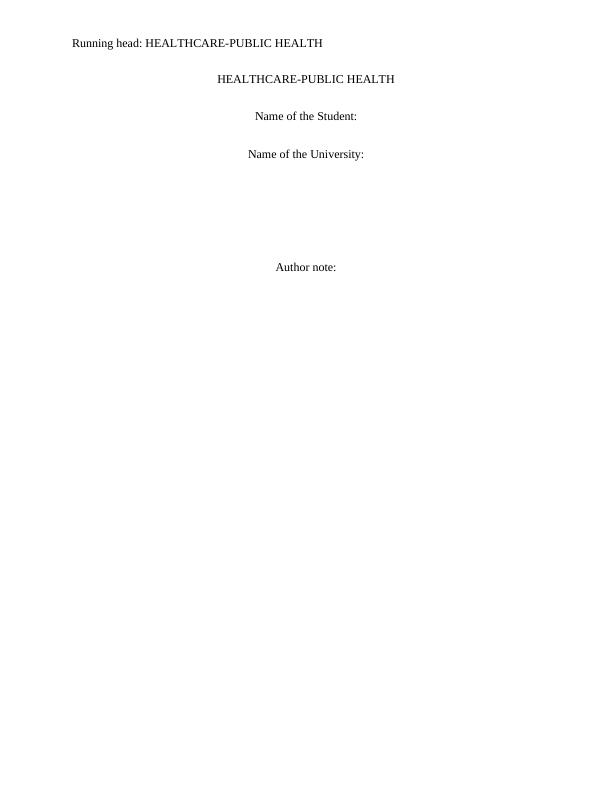
1
HEALTHCARE-PUBLIC HEALTH
Introduction of Leaflets in an Organization for Patient Better Understanding of His Disease-
Diabetes
Introduction
Change is occurring at a rapid pace in the healthcare sector. Hospitals are merging with
formation of large medical group, clinically integrated networks, introduction of patient
education tools in addition to integrated delivery networks. Thus, leaders are involved in due
diligence and transitional processes, which seek corporate structures, patient knowledge and
awareness, patient benefits, and with facilities. Ginter, Duncan and Swayne (2018) have noted
that one of the key concerns in healthcare management is management of change and healthcare
professionals are obligated in order to attain and maintain the proficiency required to undertake
their professional tasks and are obligated to execute only those tasks, which are within their
competence. Effective change within organizations has been characterized as unfreezing old
behaviours, introducing new strategies and further re-freezing them. However, change may be
permanent, random, intermittent or atypical. Moreover, conventional change permits time for
groundwork and research, while on the other side unpredictable change tends to be more difficult
to respond effectively. However, as change management in healthcare tend to occur at a frequent
pace, they show less predictability. Changes management in healthcare sectortend to be
receptive if they improve quality and safety of their services and further develop the awareness
level of patients. Nevertheless, it is essential to adapt health care delivery to the needs and
demands of the local populace and efficiently boost awareness initiatives and programmes with
distinctand direct communication between the patients and organization (Wager, Lee & Glaser,
2017). Studies of Ginter, Duncan and Swayne (2018) have noted that, the rate of change
management in healthcare sector is elevating and dynamic forces have been effectively
HEALTHCARE-PUBLIC HEALTH
Introduction of Leaflets in an Organization for Patient Better Understanding of His Disease-
Diabetes
Introduction
Change is occurring at a rapid pace in the healthcare sector. Hospitals are merging with
formation of large medical group, clinically integrated networks, introduction of patient
education tools in addition to integrated delivery networks. Thus, leaders are involved in due
diligence and transitional processes, which seek corporate structures, patient knowledge and
awareness, patient benefits, and with facilities. Ginter, Duncan and Swayne (2018) have noted
that one of the key concerns in healthcare management is management of change and healthcare
professionals are obligated in order to attain and maintain the proficiency required to undertake
their professional tasks and are obligated to execute only those tasks, which are within their
competence. Effective change within organizations has been characterized as unfreezing old
behaviours, introducing new strategies and further re-freezing them. However, change may be
permanent, random, intermittent or atypical. Moreover, conventional change permits time for
groundwork and research, while on the other side unpredictable change tends to be more difficult
to respond effectively. However, as change management in healthcare tend to occur at a frequent
pace, they show less predictability. Changes management in healthcare sectortend to be
receptive if they improve quality and safety of their services and further develop the awareness
level of patients. Nevertheless, it is essential to adapt health care delivery to the needs and
demands of the local populace and efficiently boost awareness initiatives and programmes with
distinctand direct communication between the patients and organization (Wager, Lee & Glaser,
2017). Studies of Ginter, Duncan and Swayne (2018) have noted that, the rate of change
management in healthcare sector is elevating and dynamic forces have been effectively
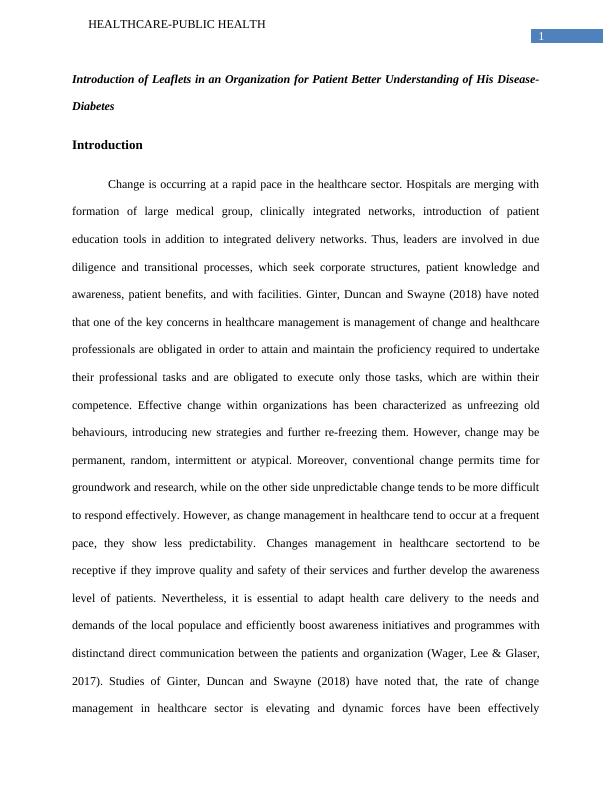
2
HEALTHCARE-PUBLIC HEALTH
transforming healthcare. Such accelerating change in healthcare has the ability to produce
extensive economic potential for organizations who are seeking to employ effective survival
techniques in their immediate plan for success of their organization. However, in order to
accomplish this, healthcare organization must harness the forces and determinants, which are
driving transformation and implement them to its advantage. Furthermore, Greene, Hibbard,
Sacks, Overton and Parrotta (2015) have noted that the change in health services primarily
involves incremental development on current organizational capabilities, increasing
empowerment to the altering agents in addition to continuous support to the changing leaders.
The following essay aims to evaluate a change management in ABC healthcare organization,
which is aiming to introduce leaflets for patient better understanding of disease such as diabetes.
Discussion
ABC healthcare Organisational structures respond to political and social change
Current political as well as economic developments in addition to related changes in the
practice as well as delivery of health and social care services have led organizational leaders,
managers as well as professionals to distinguish the significance and links between problem
solving and decision-making proficiency. Specifically, measuring the impact of political,
economic, socio-cultural, environmental in addition to other external influences upon health care
policy, suggestions and organisational programmes has developed into a recognisable stage of
health service strategic development as well as planning mechanisms.
Political- Reports of Ginter, Duncan and Swayne (2018) have revealed that over the past two
decades ABC health care has benefitted from lower taxation policies throughout the western
hemisphere. It has emerged in high profits as well as growing spending in the domain of research
HEALTHCARE-PUBLIC HEALTH
transforming healthcare. Such accelerating change in healthcare has the ability to produce
extensive economic potential for organizations who are seeking to employ effective survival
techniques in their immediate plan for success of their organization. However, in order to
accomplish this, healthcare organization must harness the forces and determinants, which are
driving transformation and implement them to its advantage. Furthermore, Greene, Hibbard,
Sacks, Overton and Parrotta (2015) have noted that the change in health services primarily
involves incremental development on current organizational capabilities, increasing
empowerment to the altering agents in addition to continuous support to the changing leaders.
The following essay aims to evaluate a change management in ABC healthcare organization,
which is aiming to introduce leaflets for patient better understanding of disease such as diabetes.
Discussion
ABC healthcare Organisational structures respond to political and social change
Current political as well as economic developments in addition to related changes in the
practice as well as delivery of health and social care services have led organizational leaders,
managers as well as professionals to distinguish the significance and links between problem
solving and decision-making proficiency. Specifically, measuring the impact of political,
economic, socio-cultural, environmental in addition to other external influences upon health care
policy, suggestions and organisational programmes has developed into a recognisable stage of
health service strategic development as well as planning mechanisms.
Political- Reports of Ginter, Duncan and Swayne (2018) have revealed that over the past two
decades ABC health care has benefitted from lower taxation policies throughout the western
hemisphere. It has emerged in high profits as well as growing spending in the domain of research

3
HEALTHCARE-PUBLIC HEALTH
and development. However, recent Brexit has led to changes in the taxation policies. Secondly,
as per the view of Renedo, Marston, Spyridonidis and Barlow (2015), local governments are
further seeking into Healthcare Facilities explicit taxation policies to control the carbon footprint
of the U.K Healthcare sector.
Social- According to Tewahido and Berhane (2017), there is an escalating development of
income inequality in the U.K. This has altered the power structure which has been highly
persistent in the society for over the past 6-7 decades.
Consequences of poor patient understanding of illness
Communication barriers frequently remain unobserved in healthcare settings and thus
result tosevereoutcomes on the health as well as safety of patients. Studies of authors have noted
that inadequate and limited literacy skills are considered one of the critical predictors of poor
health outcomes for patients. Moreover, research conducted by Donetto, Pierri, Tsianakas and
Robert (2015) have revealed that patients with low reading abilities, and lack of awareness of
diseases they are suffering tend to show significant degree of incompetence at managing their
health or understand the consequences of their illness thus show high inability to take preventive
measures for their health. On the other hand, Wager, Lee and Glaser (2017) have claimed that
patients do not need to have limited literacy skills to have low health literacy. Renedo, Marston,
Spyridonidis and Barlow (2015) have noted that the extent to which individuals have the
competence to acquire, generate and identify basic health information as well as services needed
to make suitable health decisions. According to Verma, Luo, Subramaniam, Sum and Stahl et al.
(2017), limited health literacy is identified as an unknown epidemic, which can pose challenges
to individual’s health status, health outcomes in addition to health care treatment as well as
HEALTHCARE-PUBLIC HEALTH
and development. However, recent Brexit has led to changes in the taxation policies. Secondly,
as per the view of Renedo, Marston, Spyridonidis and Barlow (2015), local governments are
further seeking into Healthcare Facilities explicit taxation policies to control the carbon footprint
of the U.K Healthcare sector.
Social- According to Tewahido and Berhane (2017), there is an escalating development of
income inequality in the U.K. This has altered the power structure which has been highly
persistent in the society for over the past 6-7 decades.
Consequences of poor patient understanding of illness
Communication barriers frequently remain unobserved in healthcare settings and thus
result tosevereoutcomes on the health as well as safety of patients. Studies of authors have noted
that inadequate and limited literacy skills are considered one of the critical predictors of poor
health outcomes for patients. Moreover, research conducted by Donetto, Pierri, Tsianakas and
Robert (2015) have revealed that patients with low reading abilities, and lack of awareness of
diseases they are suffering tend to show significant degree of incompetence at managing their
health or understand the consequences of their illness thus show high inability to take preventive
measures for their health. On the other hand, Wager, Lee and Glaser (2017) have claimed that
patients do not need to have limited literacy skills to have low health literacy. Renedo, Marston,
Spyridonidis and Barlow (2015) have noted that the extent to which individuals have the
competence to acquire, generate and identify basic health information as well as services needed
to make suitable health decisions. According to Verma, Luo, Subramaniam, Sum and Stahl et al.
(2017), limited health literacy is identified as an unknown epidemic, which can pose challenges
to individual’s health status, health outcomes in addition to health care treatment as well as
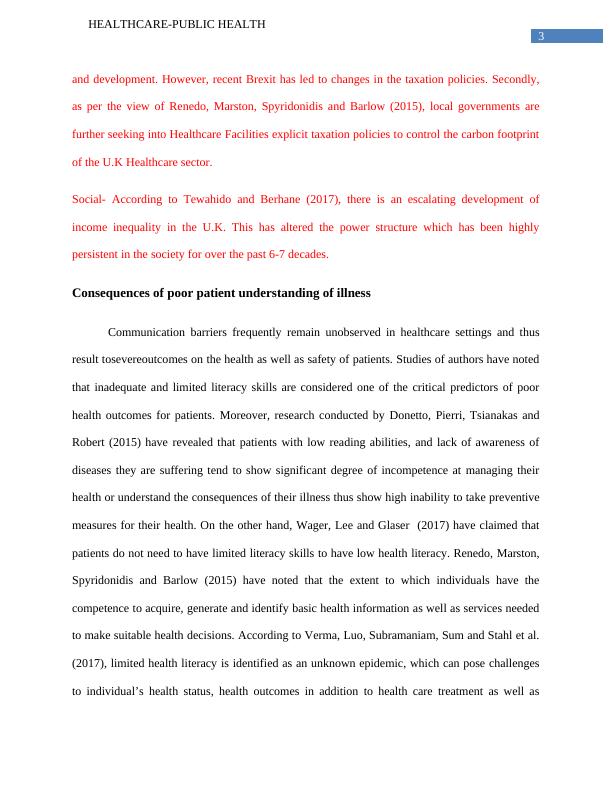
4
HEALTHCARE-PUBLIC HEALTH
health expenses. It is important to note that health care system often depend on the assumption
that patients will be able to comprehend complex written as well as spoken information.
Furthermore, as per the study of authors, many hospitals expect their patients to navigate a
multifaceted medical system and then handle highly complex treatment procedures at home. At
this juncture, Tewahido and Berhane (2017) have mentioned that majority of patients fail to
understand health information provided to them and thus cannot take necessary actions and make
appropriate health decisions.
Self-supervision and patient understanding of illness diabetes
In contemporary diabetic management, patients are typically encouraged to take
accountability for aspects of their own treatment and care (Renedo, Marston, Spyridonidis&
Barlow, 2015). There can be identified several components of attainable enduring patient-based
management which entails self-medication, annual examination of health condition in addition to
contribution from dietetic services along with monitoring blood glucose level and usual
screening for problems related to eyes and feet. Range of diverse healthcare professionals often
performs such varied management strategies either single-handedly or in grouping. Studies of
Donetto, Pierri, Tsianakasand Robert(2015) have noted that as risk of complication elevates with
diabetes, effective optimization of self-care strategies in diabetes patients where risks tend to be
higher is considered highly crucial. Thus, to attain these aims, diabetes patients require an
improved understanding of their health conditions and must be adequately intact cognitively as
well as motivated to proficiently make suitable decisions regarding their health conditions.
According to Greene, Hibbard, Sacks, OvertonandParrotta (2015), it is essential for patients with
diabetes to provide relevant information to their doctors in consultation and further to make their
own information requirements recognized. Such a type of management will mainly call for
HEALTHCARE-PUBLIC HEALTH
health expenses. It is important to note that health care system often depend on the assumption
that patients will be able to comprehend complex written as well as spoken information.
Furthermore, as per the study of authors, many hospitals expect their patients to navigate a
multifaceted medical system and then handle highly complex treatment procedures at home. At
this juncture, Tewahido and Berhane (2017) have mentioned that majority of patients fail to
understand health information provided to them and thus cannot take necessary actions and make
appropriate health decisions.
Self-supervision and patient understanding of illness diabetes
In contemporary diabetic management, patients are typically encouraged to take
accountability for aspects of their own treatment and care (Renedo, Marston, Spyridonidis&
Barlow, 2015). There can be identified several components of attainable enduring patient-based
management which entails self-medication, annual examination of health condition in addition to
contribution from dietetic services along with monitoring blood glucose level and usual
screening for problems related to eyes and feet. Range of diverse healthcare professionals often
performs such varied management strategies either single-handedly or in grouping. Studies of
Donetto, Pierri, Tsianakasand Robert(2015) have noted that as risk of complication elevates with
diabetes, effective optimization of self-care strategies in diabetes patients where risks tend to be
higher is considered highly crucial. Thus, to attain these aims, diabetes patients require an
improved understanding of their health conditions and must be adequately intact cognitively as
well as motivated to proficiently make suitable decisions regarding their health conditions.
According to Greene, Hibbard, Sacks, OvertonandParrotta (2015), it is essential for patients with
diabetes to provide relevant information to their doctors in consultation and further to make their
own information requirements recognized. Such a type of management will mainly call for
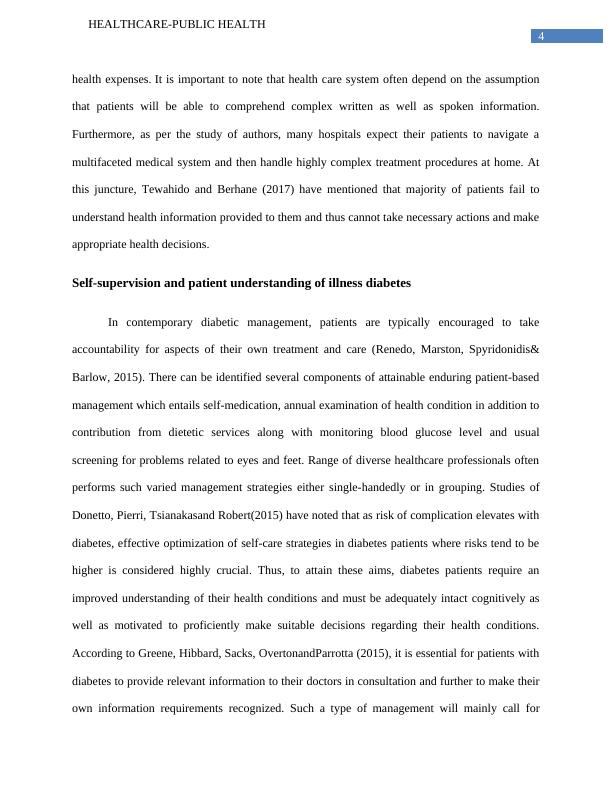
5
HEALTHCARE-PUBLIC HEALTH
diabetes patients to actively participate in the treatment process. In the view of Ginter, Duncan
and Swayne (2018), previous patient intervention studies have successfully influenced patient
participation and queries while patients repeatedly posting queries tend to raise tension, stress
and negative impact on the patients. At this juncture, the use of patient education leaflet has been
highlighted which supports strong patient involvement and participation.
Drawing relevance to these factors, ABC healthcare organization has recently
emphasized on the role of the ‘good’ patient as an efficient provider of information broadening
beyond the recitation of symptoms in order to embrace insights ofexplanation and meaning.
Patient information leaflet (PIL) is identified as an effective educational material for
transmission of patient education regarding disease, treatments, and medications in addition to
lifestyle changes for improved patient outcomes. The PIL introduced by ABC healthcare, which
included every medicine package with explicitly documented written information about the
treatment. With the increasing rate of complexities faced by patientsABC healthcare has realized
the use of PIL and identified it as akey management strategies for curing as well as preventing
the development of diabetes.
Role of Clinical Leadership in Change Management
Effectively change management signifies that clinical leaders necessitate a tool kit of
skills, strategies and techniques and the enthusiasm to executethe change. Al-Haddad and
Kotnour (2015) have noted that development of any new healthcare services is based on effective
change and thus leadership is imperative in developing, introducing as well as executing the
change. ABC healthcare in order to introduce PIL as an important patient information tool must
apply the theory of clinical leadership in order to efficiently instigate innovative change mainly
HEALTHCARE-PUBLIC HEALTH
diabetes patients to actively participate in the treatment process. In the view of Ginter, Duncan
and Swayne (2018), previous patient intervention studies have successfully influenced patient
participation and queries while patients repeatedly posting queries tend to raise tension, stress
and negative impact on the patients. At this juncture, the use of patient education leaflet has been
highlighted which supports strong patient involvement and participation.
Drawing relevance to these factors, ABC healthcare organization has recently
emphasized on the role of the ‘good’ patient as an efficient provider of information broadening
beyond the recitation of symptoms in order to embrace insights ofexplanation and meaning.
Patient information leaflet (PIL) is identified as an effective educational material for
transmission of patient education regarding disease, treatments, and medications in addition to
lifestyle changes for improved patient outcomes. The PIL introduced by ABC healthcare, which
included every medicine package with explicitly documented written information about the
treatment. With the increasing rate of complexities faced by patientsABC healthcare has realized
the use of PIL and identified it as akey management strategies for curing as well as preventing
the development of diabetes.
Role of Clinical Leadership in Change Management
Effectively change management signifies that clinical leaders necessitate a tool kit of
skills, strategies and techniques and the enthusiasm to executethe change. Al-Haddad and
Kotnour (2015) have noted that development of any new healthcare services is based on effective
change and thus leadership is imperative in developing, introducing as well as executing the
change. ABC healthcare in order to introduce PIL as an important patient information tool must
apply the theory of clinical leadership in order to efficiently instigate innovative change mainly
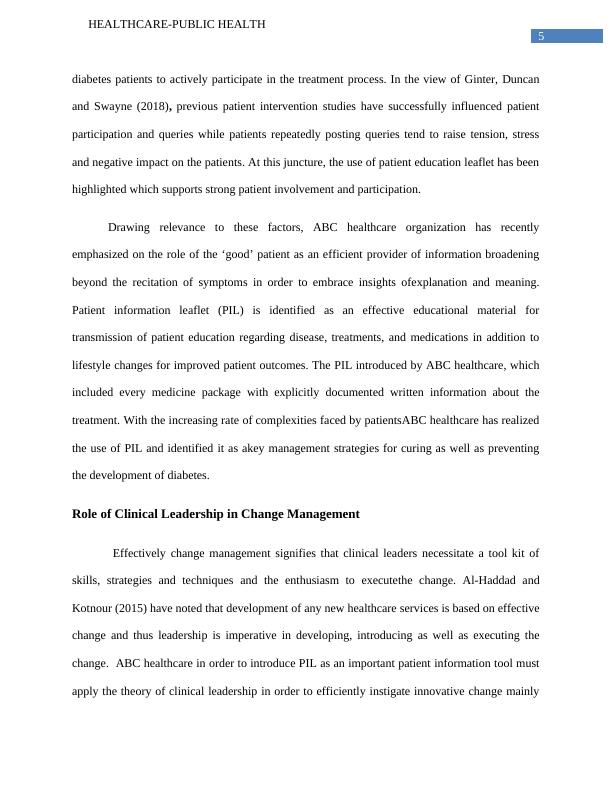
End of preview
Want to access all the pages? Upload your documents or become a member.
Related Documents
Effective Leadership in Healthcare: Styles, Techniques, and Challengeslg...
|16
|4388
|57
Health Human Resource Managementlg...
|5
|768
|94
Legal and Professional Issues in Nursinglg...
|4
|675
|494
Effective Leadership in Health: Importance and Styleslg...
|12
|2966
|300
Change Management in Healthcare (Doc)lg...
|16
|3593
|39
Reflection Paper On Strategic Management -lg...
|5
|827
|18
